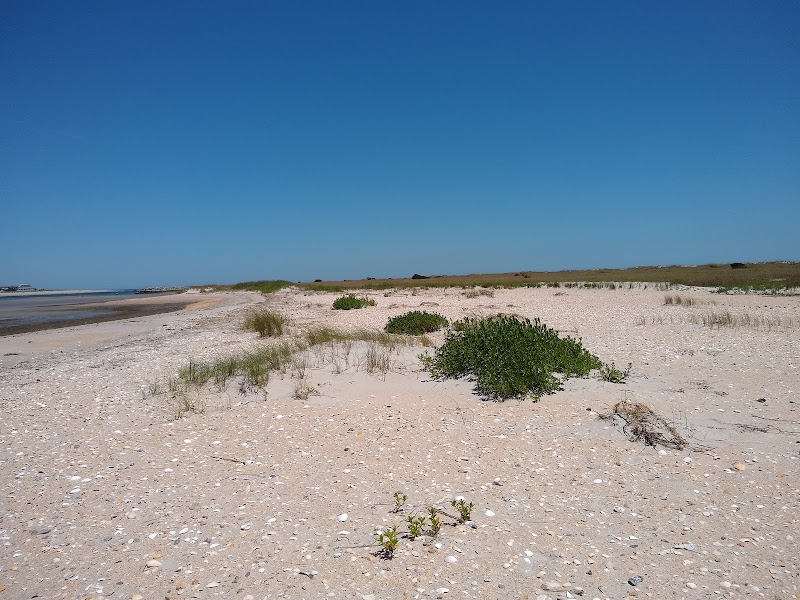
Masonboro Island State Natural Area Adventures
Masonboro Island State Natural Area is a pristine barrier island in North Carolina, popular for its untouched beaches and diverse wildlife.
Popular Activities
Journey Through the Untamed Wilderness of Masonboro Island: An Adventurer's Guide to Capturing Nature's Raw Beauty
Standing amidst the windswept dunes and the rhythmic serenade of ocean waves, Masonboro Island State Natural Area offers an unadulterated gateway into North Carolina's coastal treasures. This barrier island, accessible only by boat, is a siren call to adventurers and photographers yearning for raw, untouched landscapes. As you set foot on the soft, undulating sands, the world behind fades, leaving only the beckoning horizon ahead.
Masonboro Island extends over eight miles, a stretch of pristine shoreline that hums with the whispered histories of maritime forests, salt marshes, and sandy dunes. Here, the Atlantic Ocean kisses the island’s eastern edge, while the quiet estuarine waters of Masonboro Sound rest to the west. Each breath carries the salt-laden air, invigorating the spirit and promising a day enveloped by nature’s vastness.
For photographers, capturing this location involves more than just images—it’s about seizing the island’s essence. Mornings bring a soft dance of light as the sun rises, casting a golden hue over the land. The early hours are perfect for photographing the island’s dynamic seascapes, where the meeting of water and sky births a canvas of shifting colors. As the sun climbs, explore the marshland trails where spartina grass sways like whispers sharing secret tales. In these areas, wildlife photographers might glimpse the elegance of herons or the bustling life of fiddler crabs, each scene deserving of their place in your photographic journey.
Transitioning from the marshes to the interior trails, one finds a network of paths threading through maritime forests. The vegetation, with its resilience against coastal storms, inspires a deeper appreciation for life's tenacity. Photographers will find these woods whisper stories etched in the wind-worn bark that's steeped in shades of greens and browns.
Planning a successful expedition here demands awareness and preparation. First, consider the tides—they rule the passage to and from the island. A rising tide might cover pathways and cut off key parts of the island, shaping your trek. Footwear should be sturdy yet light, preparing you for the soft sands and wet marsh trails. Hydration is crucial; the sun's embrace can turn harsh swiftly, urging you to balance your awe of the beauty with the practical need for sustenance.
Despite its isolation, Masonboro is alive with activity on the water. Kayakers and stand-up paddleboarders glide across the gentle waves, partaking in closer communion with the land and sea. For those wishing to capture water sports photography, the interplay between humans and nature provides endless opportunities for dynamic shots.
This island’s magic may charm any who visit, but it demands respect. Lush yet delicate, the ecosystems are sensitive to intrusion. Leave no trace becomes a mantra—not simply a guideline but a vow to protect the sanctity of this natural haven for future explorers.
Masonboro Island offers an adventure free from modern interruptions, a journey seasoned with the spice of nature’s unpredictability. It stands as a raw embodiment of coastal splendor, ready to etch memories into the adventurous spirit, and beckons those with a camera lens to capture its essence. Amidst the ceaseless rhythm of wave and wind, you might find not only the perfect photograph but also a deeper connection to the untamed world around you.
Plan Your Visit
Everything you need to know to prepare for an unforgettable trip to Masonboro Island State Natural Area.
Entrance Requirements
Free access, boat required to visit.
Best Time to Visit
Spring and summer for the best wildlife viewing and calm weather.
Visitor Information
No visitor centers; information available at NC Coastal Reserve and National Estuarine Research Reserve facilities.
Getting There
No road access; boat access from public and private docks.
Weather & Climate
The area experiences mild winters and warm, humid summers, typical of the southeastern U.S. coast.
Conservation Efforts
Coastal erosion and sea level rise are significant threats; conservation efforts focus on habitat preservation and protection of nesting sites.
Camping in Masonboro Island State Natural Area
Find the perfect spot to stay overnight and immerse yourself in the details.
Top Trails
Trailblazer Tips
Bring all necessary supplies, as there are no facilities on the island.
Visit in late summer for the chance to see sea turtle hatchlings.
Access the island using public boat ramps or nearby ferry services.
Bring binoculars to enhance your birdwatching experience.
